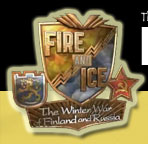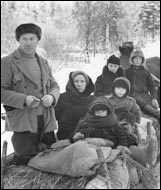

Finland was a country of less than 5 million people when the Winter War started in November 1939. The Soviet Union, a country of over 180 million people, had amassed a huge army at the Karelian doorstep to Finland and placed demands for Finnish territory, demands which the Finns refused. At 9:15 on November 30, 1939, Soviet air raids on Finland began.
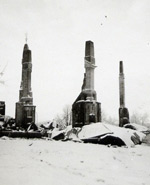 Thousands of homes in Finland were destroyed and
burned during the war. Only the chimneys remained standing.
Thousands of homes in Finland were destroyed and
burned during the war. Only the chimneys remained standing.
Marshall Kregel
Civilian centers were the main targets in some of Finland's larger cities including Helsinki, Lappeeranta, Viipuri and Kouvola. There was little differentiation between civilian and military targets. This was total war and the civilian population was in the Soviet bombsights. The Finnish people, settling in for a long dark winter, were about to have their lives changed forever. For Finland to survive, a new front line was established against the Soviets. Into this front line stormed the elderly, the children, the wives and mothers and daughters of the troops at the front. This was the home front, and if it failed, so would the Finnish army fighting hand-to-hand with the enemy in Karelia.
The home front in Finland during the war was a collaboration between the labor unions, civilians, Civil Guard, Lotta Svärd, political parties and regular army. Each part was organized in support of the total war effort to defend Finland. During World War II, the populations of the major European cities were brought into the second world war even though they were far behind the front lines. For the Finns, the home front was an essential part of the fighting. While all the men of fighting age were at the front lines, the elderly, the children and the women took their places and became the workers in the factories, the farmers, truck drivers and medical staff at all the hospitals. They sat at home and made socks and sweaters for the front line troops. They learned to run the machinery that made the ammunition for the rifles and cannons, and stood on freezing rooftops and scouted for enemy aircraft.
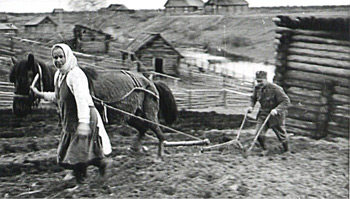
Women took over most of the chores on the farms.
Occasionally, local troops might pitch in to help plow, or bring
in the crops.
Marshall Kregel
The Finnish home front can be divided into three main categories:
The
Lotta Svärd, the Home
Army or Civil Guard, and civilian
volunteers plus regular army troops who worked behind the lines
while recovering
from wounds suffered in battle.
In Finland, the women's auxiliary corp was called the Lotta Svärd. This organization was started immediately after the War for Independence. The women were mostly trained in medical duties. During World War II, in addition to hospital duties, Lotta women were trained for tasks ranging from spotting enemy aircraft to delivering mail to soldiers in the field, and they also served as switchboard operators. In battle zones, Lotta women provided food for the soldiers. On the home front they baked bread and manufactured goods for the front lines. In 1939 the number of Lotta Svärd members jumped to about 130,000 and reached almost 173,000 by 1943. When Lotta Svärd was abolished in November 1944, it had some 150,000 active members, about 30,000 supporting members and about 52,000 Lotta-girls. New types of training introduced in late 1930s included anti-chemical weapons training, air-surveillance courses and signal training.
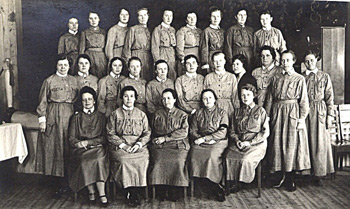
Women took over the major duties in health care
and hospital work as well as transportation, communications, clerical,
postal, and delivery of food and war materials to the front.
Marshall Kregel
Even if Lottas were not combatants, serving in Lotta Svärd during
the war wasn't risk free. Six hundred sixty-one Lottas died during
World War II.
During Continuation War 228
Lottas
lost
their
lives
while serving in locations they had been ordered to.
As many as 64 of them died from enemy action. In addition, four Lottas
went missing.
Learn more about the Lotta Svärd organization
Older conscripts in the Finnish Army belonged to the Civil Guard or Home Army. These men were trained to:
Repel attacks and hunt down saboteurs and enemy parachutists
Operate the air raid defense positions which guarded the cities
Cooperate with local authorities in maintaining the law
Supervise conscription of new recruits for the Army
Send reenforcements to the field army
Guard and otherwise look after the Soviet prisoners of war

Conscripts follow their
new sergeant. Next stop, haircuts, uniforms and the drill grounds.
Older conscripts were
inducted into the Home Army which was responsible for civil order
and home defense against air raids.
Marshall Kregel
Civilian volunteers worked in clothing manufacturing
and distribution. The clothing situation was bad when the war started.
Only the delaying
troops on the very front line had adequate clothing and equipment.
The supply elements, home front troops and replacement units were
mostly in civilian clothes, and had to manage without tents and field
kitchens. As such, civilians nationwide worked to make warm clothing
to supply the front. Civilians worked as teachers and guardians of
the children. In the cities, volunteers herded the children into
air raid shelters, or out of the city whenever enemy aircraft were
sighted. About 70,000 of these children were evacuated to Sweden
and Denmark during the war to keep them safe. Of these “war
children”, about 15,000 stayed permanently abroad and never
came home. In most cases, they had no family or home to come back
to.
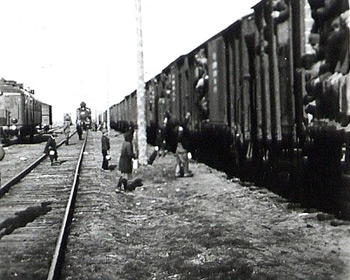
Finnish children board
trains to Sweden during the war. 70,000 children left Finland for
safety. Not all of them
had homes or family to come back to.
Marshall Kregel
Civilian volunteers worked with the fire departments,
police, as air raid wardens, coastal scouts and aircraft spotters.
Civilian
casualties during the war numbered in the thousands. Also, more than
over 2,000 homes were destroyed in Finland. This doesn't count
the number
of
homes destroyed in the occupied areas of Finland during the war.
With the loss of Karelia, more than 420,000 Finns picked up their
belongings and moved west across the new border between Finland and
Soviet Union.
Not only did Finland have to pay a huge war reparations debt to the Soviet Union, but it also had to come up with housing, jobs, and social support for the new influx of refugees from Soviet territory. This was a huge financial burden on a country whose economy depended on timber, agriculture, fishing and mining. Civilians opened up their homes to the refugees and served as administrators for refugee centers. Few countries were able to assimilate such a huge influx of people during the war.
The following paragraphs were taken from Field Marshall Mannerheim's speech to the Finnish troops on March 14, 1940, at the close of the Winter War against the Soviet Union.
"With joy and pride my thoughts dwell on the Lottas of Finland - their spirit of self-sacrifice and untiring work in many fields, work which has liberated thousands of men for the fighting line. Their noble spirit has spurred on and supported the Army, whose undivided gratitude and respect they have achieved. Posts of honour have also been those of the thousands of workers who, often as volunteers and during air-raids, have worked beside their machine for the Army's needs, or laboured unflinchingly under fire, strengthening our positions. On behalf of the Fatherland, I thank them.
After sixteen weeks of bloody battle with no rest by day or by night, our Army still stands unconquered before an enemy which in spite of terrible losses has grown in numbers; nor has our home front, where countless air-raids have spread death and terror among women and children, ever wavered. Burned cities and ruined villages far behind the front, as far even as our western border, are the visible proofs of the nation's sufferings during the past months. Our fate is hard, now that we are compelled to give up to an alien race, a race with a life philosophy and moral values different from ours, land which for centuries we have cultivated in sweat and labour. Yet, we must put our shoulders to the wheel, in order that we may prepare on the soil left to us a home for those rendered homeless and an improved livelihood for all, and as before we must be ready to defend our diminished Fatherland with the same resolution and the same fire with which we defended our undivided Fatherland".
– Marshal Mannerheim. Message to the troops. March 14, 1940.

